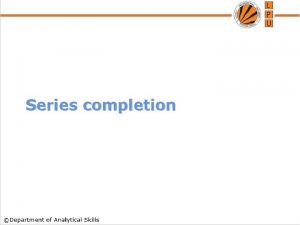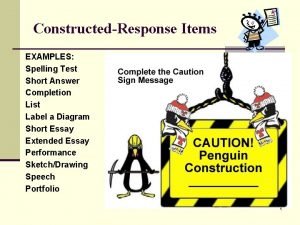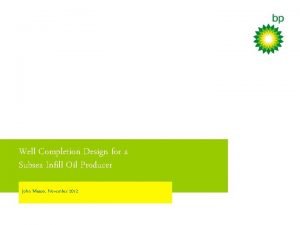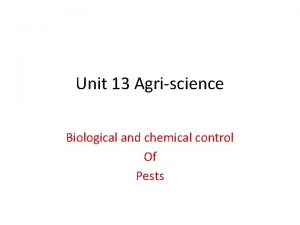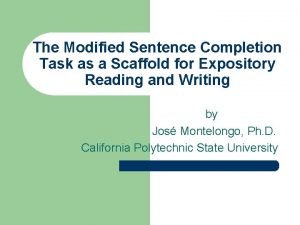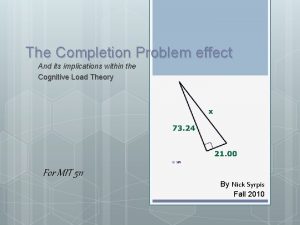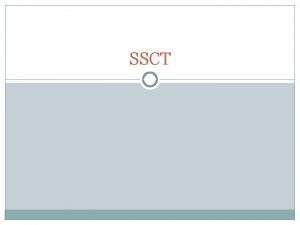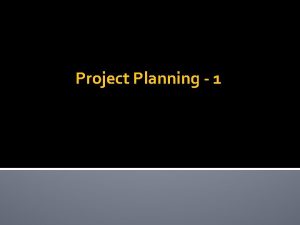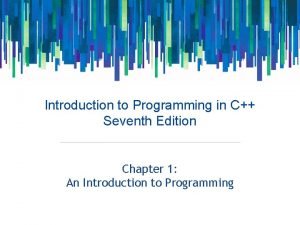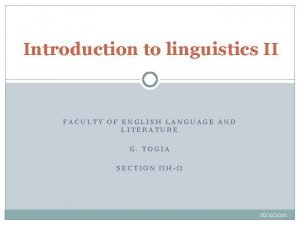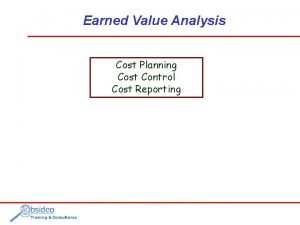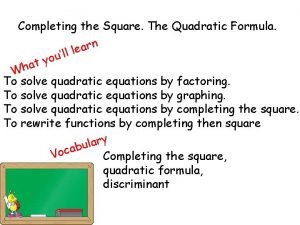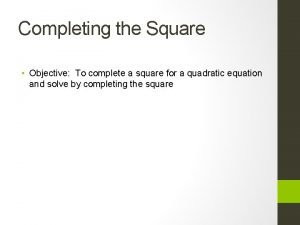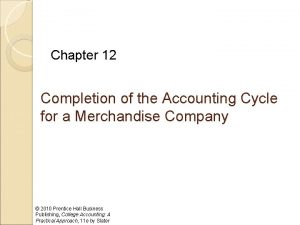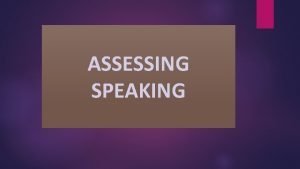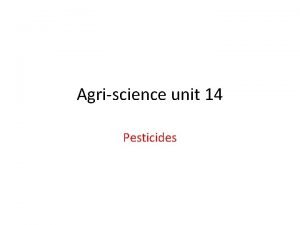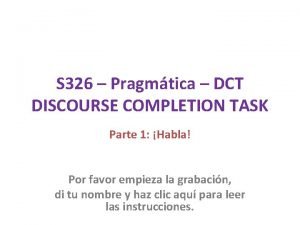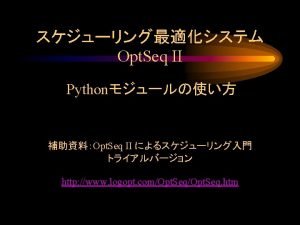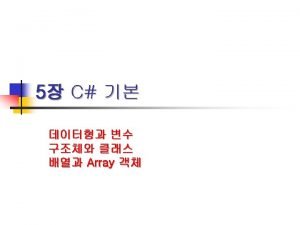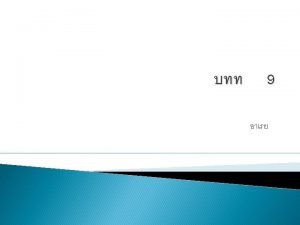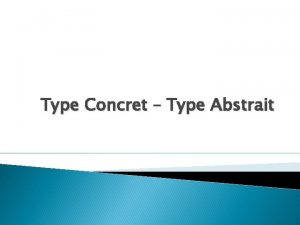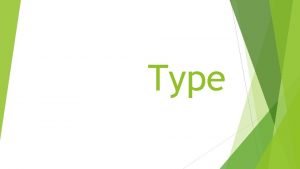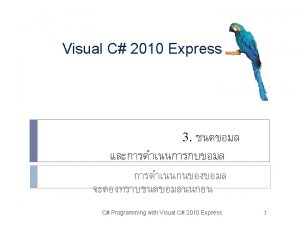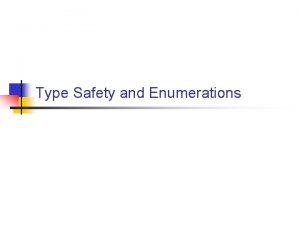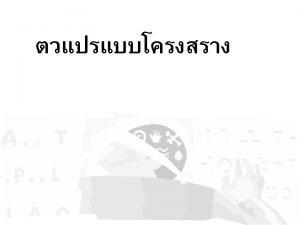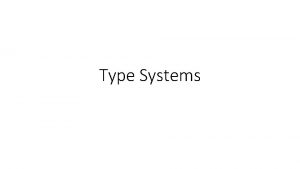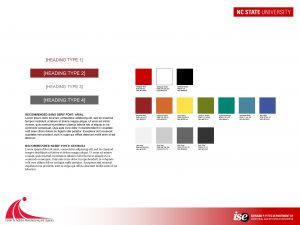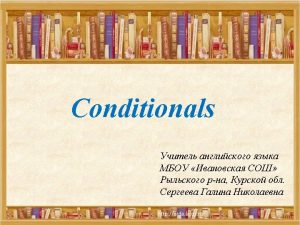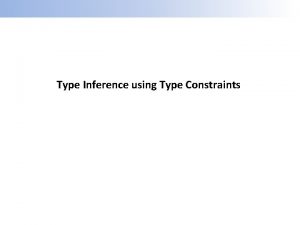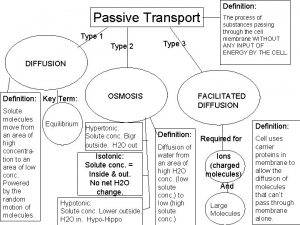Series completion Series completion In this type of























- Slides: 23

Series completion

Series completion Ø In this type of questions, some numbers and/or alphabetical letters are given. Ø They all form a series and the series changes in certain order. Ø The series may also have one or more numbers/letters missing. ØThe candidates are required to observe that specific order in which the series changes and then complete the series. ØSimilarly, the candidates have to decide about the missing letter or number that would suit for the blank space if they continue to change in some order. Some common types are explained in the following slides.

Types of Series: Number Series Alpha series Letter series Number and letter Analogy

Tricks to solve series completion Step 1: Observe are there any familiar numbers in the given series like primes numbers, perfect squares, cubes and so on which are easy to identify. Step 2: Calculate the differences between the numbers. Observe the pattern in the differences. If the differences are growing rapidly it might be a square series, cube series or multiplicative series. If the numbers are growing slowly, then it is an addition or subtraction series. If the differences are not having any pattern then 1. It might be a double or triple series. Here every alternate number or every 3 rd number form a series 2. It might be a sum or average series. Here sum of two consecutive numbers gives 3 rd number. or average of first two numbers give next number Step 3: Sometimes number will be multiplied and will be added another number. So we need to check those patterns.

Types of number series: I. Prime number Series : Example (1) : 2, 3, 5, 7, 11, 13, . . . Answer : The given series is prime number series. The next prime number is 17. Example (2) : 2, 5, 11, 17, 23, . . . 41. Answer: The prime numbers are written alternately. II. Difference Series : Example (1): 2, 5, 8, 11, 14, 17, . . . , 23. Answer: The difference between the numbers is 3. (17+3 = 20) Example (2): 45, 38, 31, 24, 17, . . . , 3. Answer: The difference between the numbers is 7. (17 -7=10).

III. Multiplication Series: Example (1) : 2, 6, 18, 54, 162, . . , 1458. Answer: The numbers are multiplied by 3 to get next number. (162 x 3 = 486). Example: (2) : 3, 12, 48, 192, . . . , 3072. Answer : The numbers are multiplied by 4 to get the next number. (192 x 4 =768). IV. Division Series: Example (1): 720, 120, 24, . . , 2, 1 Answer: 720/6=120, 120/5=24, 24/4=6, 6/3=2, 2/2=1. Example (2) : 32, 48, 72, 108, . . , 243. Answer: 2. Number x 3/2= next number. 32 x 3/2=48, 48 x 3/2=72, 72 x 3/2=108, 108 x 3/2=162.

V. n 2 Series: Example(1) : 1, 4, 9, 16, 25, . . . . , 49 Answer: The series is 12, 22, 32, 42, 52, . . The next number is 62=36; Example (2) : 0, 4, 16, 36, 64, . . . . 144. Answer : The series is 02, 22, 42, 62, etc. The next number is 102=100. VI. n 2− 1 Series : Example : 0, 3, 8, 15, 24, 35, 48, . . , Answer : The series is 12 -1, 22 -1, 32 -1 etc. The next number is 82 1=63. Another logic : Difference between numbers is 3, 5, 7, 9, 11, 13 etc. The next number is (48+15=63). VII. n 2 +1 Series : Example : 2, 5, 10, 17, 26, 37, . . , 65. Answer : The series is 12+1, 22+1, 32+1 etc. The next number is 72+1=50.

VIII. n 2+n Series (or) n 2−n Series : Example : 2, 6, 12, 20, . . . , 42. Answer : The series is 12+1, 22+2, 32+3, 42+4 etc. The next number = 52+5=30. Another Logic : The series is 1 x 2, 2 x 3, 3 x 4, 4 x 5. The next number is 5 x 6=30. Another Logic : The series is 22 -2, 32 -3, 42 -4, 52 -5. The next number is 62 -6=30. IX. n 3 Series : Example : 1, 8, 27, 64, 125, 216, . . Answer : The series is 13, 23, 33, etc. The missing number is 73=343. X. n 3+n Series : Example : 2, 9, 28, 65, 126, 217, 344, . . . Answer : The series is 13+1, 23+1, 33+1, etc. The missing number is 83+1=513.

XI. n 3− 1 Series : Example : 0, 7, 26, 63, 124, . . . , 342. Answer: The series is 13 -1, 23 -1, 33 -1 etc. The missing number is 63 -1=215. XII. n 3+n Series : Example : 2, 10, 30, 68, 130, . . . , 350. Answer : The series is 13+1, 23+2, 33+3 etc. The missing number is 63+6=222. XIII. n 3−n Series : Example : 0, 6, 24, 60, 120, 210, . . . , Answer : The series is 13 -1, 23 -2, 33 -3, etc. The missing number is 73 -7=336. Another Logic : The series is 0 x 1 x 2, 1 x 2 x 3, 2 x 3 x 4, etc. The missing number is 6 x 7 x 8=336.

XIV. n 3+n 2 Series : Example : 2, 12, 36, 80, 150, . . . , Answer: The series is 13+12, 23+22, 33+32 etc. The missing number is 63+62=252 XV. n 3−n 2 Series: Example: 0, 4, 18, 48, 100, . . . . , Answer : The series is 13 -12, 23 -22, 33 -32 etc. The missing number is 63 -62=180 XVI. xy, x+y Series: Example: 48, 12, 76, 13, 54, 9, 32, . . . . , Answer : 4+8=12, 7+6=13, 5+4=9 , 3+2=5. XVII. Factorial Series: Example: 1, 1, 2, 6, 24, 120, ………. . , Answer : 0!=1, 1!=1, 2!=2, 3!=6, 4!=24, 5!=120, 6!=720

Alpha Series: In following alphabet series , one term missing as shown by question mark (? ). Choose missing term from options. U, O, I, ? , A (a) E (b) C (c) S (d) G Ans: a 1) The series consists of vowles A, E, I, O, U written in a reverse order.

2) In following alphabet series , one term missing as shown by question mark. Choose missing term from options. Y, W, U, S, Q, ? N, J (b) M, L (c) J, R (d) L, M (e) O, M Ans: e The series consists of alternate letters in reverse order. (a)

2) In following alphabet series , one term missing as shown by question mark. Choose missing term from options. C, G, K, Q, ? a) W b) T c) S d) R Ans: W (Vowels+2)

4) Find the missing term. ELFA, GLHA, ILJA, _____, MLNA (a) OLPA (b) KLMA (c) LLMA (d) KLLA Ans: d The second and forth letters in the series, L and A, are static. The first and third letters consist of an alphabetical order beginning with the letter E.

3) Find the missing term. WFB, TGD, QHG, ? (a) NIJ (b) NIK (c) NJK (d) OIK (e) PJK Ans: b W -3 T -3 Same pattern follows. Q -3 N

Letter series: Q 1. Complete the series. ba_ba_bac_acb_cbac aacb bbca ccba cbac None of these Ans: c A) B) C) D) E)

Q 2. n_mnp_ _ p_ npmn_ mnp a) pmnpm b) pmnpp c) pmnmp d) pnpmn e) Pppmn Ans: c The block of letters npm has been repeated.

Q 3. Find the last 5 missing letters of the series. pq_st_p_rss_pq _ _ _ a) rstqp b) tsrqp c) rstpq d) rtspq e) Prstq Ans: c The last letter of each block of 5 letters is brought in the beginning of the next block.

Number and letter Analogy: Q 1. 3 : 12 : : 5 : ? 25 (b) 35 (c) 30 (d) 15 Ans: c (a) 3 5 (32)+3 (52)+5 12 30

Q 2. 14 : 9 : : 26 : ? 12 (b) 13 (c) 31 (d) 15 Ans: D (a) 14 = (2 x 9 - 4) 26 = (2 x 15 - 4) ? = 15 Or 7 x 2=14, 7+2=14

Q 3. MO : 13 11 : : HJ : ? 19 17 (b) 18 16 (c) 8 10 (d) 16 18 Ans: b Number of alphabets after. (a)

Q 3. 7, 13, 20, 27, ? 39 (b) 35 (c) 42 (d) 36 Ans: 36 5 x 1+2=7 5 x 2+3=13 5 x 3+5=20 5 x 4+7=27 5 x 5+11=36 (a)

Q 3. 12, 14, 31, 98, 399, ? 2003 (b) 2006 (c) 2005 (d) 2011 (a) Ans: 2006
 Wfb tgd qhg
Wfb tgd qhg Series completion tricks
Series completion tricks Completion item
Completion item Well completion
Well completion Unit 13 biological cultural and chemical control of pests
Unit 13 biological cultural and chemical control of pests Sentence completion activity
Sentence completion activity Completion problems
Completion problems Test ssct
Test ssct Semantic scene completion from a single depth image
Semantic scene completion from a single depth image Texas railroad commission query
Texas railroad commission query Adequate planning leads to the correct completion of work
Adequate planning leads to the correct completion of work The selection structure is the completion of
The selection structure is the completion of Completion point linguistics
Completion point linguistics Estimate at completion
Estimate at completion Completion of the square
Completion of the square Complete the square steps
Complete the square steps Percentage of completion method
Percentage of completion method Completion of the accounting cycle
Completion of the accounting cycle Www.mhhe.com/yacht 2019
Www.mhhe.com/yacht 2019 Certificate of completion special education
Certificate of completion special education Intensive speaking
Intensive speaking Unit 14 safe use of pesticides
Unit 14 safe use of pesticides Discourse completion task
Discourse completion task Seguro completion bond
Seguro completion bond

